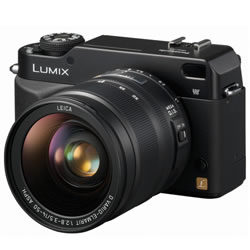Panasonic DMC-L1K Lumix Digital Camera
Panasonic Updated: 2007-06-21Easily Accessible Controls and Intuitive Operation
The DMC-L1 features analog-like controls that feel comfortable and instantly familiar. You can easily adjust settings with the touch of a fingertip, check them with a quick glance, and set the exposure intuitively. Turn the aperture ring with your left hand (which supports the lens) and operate the shutter speed dial with your right hand (holding the camera body). These two controls adjust the exposure, which is critical in picture quality. For photographers who consider the way a camera feels an important part of photo shooting, the DMC-L1 is a revolutionary digital camera. It's easy to use and feels just right in your hands. Each time you make a 1/3-EV step adjustment of either the shutter speed or the aperture, the camera responds with a reassuring click.
This easy-to-operate, easy-to-understand, analog-like system also lets you select the exposure mode by simply placing the aperture ring and shutter speed dial in the positions shown in the chart below:
Lever-operated light metering mode and drive mode
The systems switching the light metering and drive mode use independent mechanical levers. Our light metering mode lever lets you instantly select intelligent multiple metering, center weighted metering or spot metering. While the drive mode lever allows one-touch selection of single-frame shooting, burst shooting, auto-bracket shooting, or the self-timer.
The First Leica Lens Specifically Designed for a Digital SLR
The LEICA D VARIO-ELMARIT 14-50mm/F2.8-3.5 ASPH. comprises 16 elements in 12 groups, with two glass molded aspherical lenses that feature large diameters and high dimensional precision. Other advanced features include a carefully applied multi-coating to prevent flare and a circular aperture that produces a beautiful dimensional ambience. The focusing system is entirely internal, so the external length of the lens doesn't change during focusing. In addition, the 14-50mm focal length is equivalent to 28-100mm on a 35mm film format. From wide angle to zoom, this lens does it all. You can take incredible portraits and expansive landscape photos. The minimum focusing distance is just 29 cm over the entire zoom range, so you can capture 0.32x close-ups (35mm equivalent).
Taking Hand Movement Out of the Picture with MEGA Optical Image Stabilization
The LEICA D VARIO-ELMARIT is the first Leica D lens1 and first Four Thirds™ lens to incorporate Panasonic's advanced MEGA Optical Image Stabilization. More often than not, blurry photos are caused by slight hand-shake (not poor focusing performance, which is a common misconception). This technology compensates for hand-shake to help prevent blurring, so you can catch clear, sharp shots every time you shoot. There are also two image stabilization modes to suit your needs. In Mode 1, the image is corrected continually, so you can see the image clearly on the LCD monitor. Mode 2 corrects the image2 the instant you press the shutter button providing higher quality pictures.
Four Thirds™ Standard
The lens mount system used in the DMC-L1 is based on the Four Thirds™ open standard. This helps provide the optimal lens design for digital photography while also making it possible to create a lens that is small in size without sacrificing focal distance or brightness. Use of the Four Thirds™ Standard also means the DMC-L1 can use lenses made by other manufacturers using the same standard-providing you with an extensive range of interchangeable lenses to choose from.
Preview Your Images Live on the LCD Monitor
The ability to shoot while viewing the LCD monitor is an advantage offered only by digital cameras. With a viewing angle that approaches 100%, the LCD monitor makes it easy to frame shots and gives you a wealth of information at a glance. This lets you check the colors after adjusting the white balance or view the changes from exposure compensation before you shoot. You can also compose your shots without having to look in the viewfinder when using a tripod. By combining the Live MOS sensor's full-time image output with a mirror-raising mechanism, the DMC-L1 provides a preview function that displays the exact same image signal on the LCD monitor that the sensor receives through the lens. It is also possible to display a preview of the image using the aperture preview button, to check the depth of field before you shoot.
Dust Reduction System Helps Protect the Inside of the Camera
If dust collects on a digital camera's imaging sensor, every photo the camera takes will be affected. Dust entering the camera while changing the lens is one of the biggest problems with digital SLR cameras featuring interchangeable lenses. We help solve this problem with our dust reduction system. A special Supersonic Wave Filter is positioned in front of the imaging sensor, between the low-pass filter and shutter. Every time the camera is switched on, this filter generates supersonic vibrations at a rate of around 30,000 per second to shake off dust and other particles from the sensor. The area between the sensor and the filter is completely airtight; and the dust is collected by a dust absorption section below the filter.
Operating Instruction
An instruction manual about DMC-L1K Firmware Update
Related Manuals
Panasonic DMC-TZ1K/TZ1S Lumix Digital Camera
Panasonic DMC-FZ50S/FZ50K Lumix Digital Camera
Panasonic DMC-LS70S Lumix Digital Camera
Panasonic DMC-LX2S/LX2K Lumix Digital Camera
Panasonic DMC-FX50S/FX50K Lumix Digital Camera
Panasonic DMC-LZ6S Lumix Digital Camera
Panasonic DMC-FX07R/FX07A/FX07S/FX07K Lumix Digital Camera
Panasonic DMC-LZ7S/LZ7K Lumix Digital Camera
Panasonic DMC-FX3S/FX3K Lumix Digital Camera
Panasonic DMC-FX10S/FX10P/FX10A Lumix Digital Camera
Panasonic DMC-FX01S/FX01P/FX01K Lumix Digital Camera
Panasonic DMC-FX30T/FX30S/FX30K/FX30A Lumix Digital Camera
